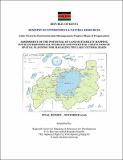| dc.description.abstract | Lake Victoria is Africa‟s largest and the world‟s second largest freshwater lake. It is one of the most important shared natural resource of Eastern Africa. The basin comprises of eleven major river basins and a large lakeshore. It supports a population estimated to be over 30 million which is considered to be one of the poorest segments of rural population in the world. Historically, the vegetation of the Lake Victoria shores was dominated by papyrus in extensive wetlands and most of the basin was covered by forests. However, a combination of rapid population growth rates in rural and urban areas, increasing dependency on natural resources as a livelihood means, inadequate planning on use of land and water resources and high poverty levels in the basin has put considerable pressure on land, vegetation and water resources. This pressure is resulting in unsustainable development in the basin with negative effects such as accelerated soil erosion, increasing deforestation, rising air and water pollution, declining fisheries, loss of biodiversity and incremental wetland loss. The consequences are a decline in food security, rising health problems, reduced incomes from agricultural, livestock and fisheries activities and hence increasing poverty | en_US |

